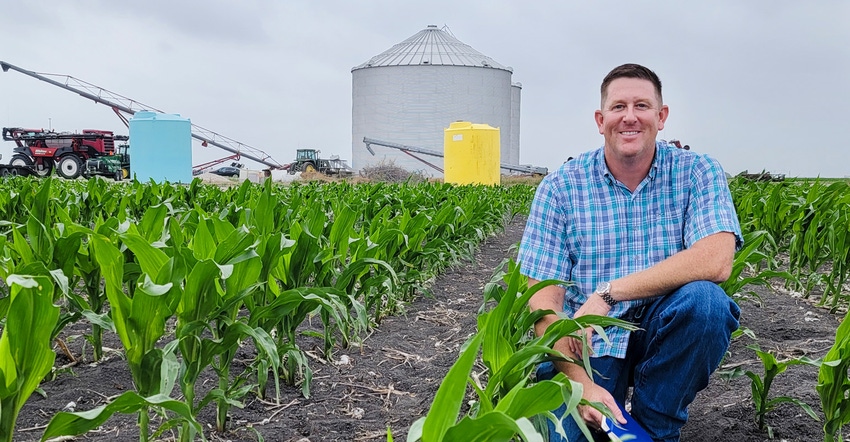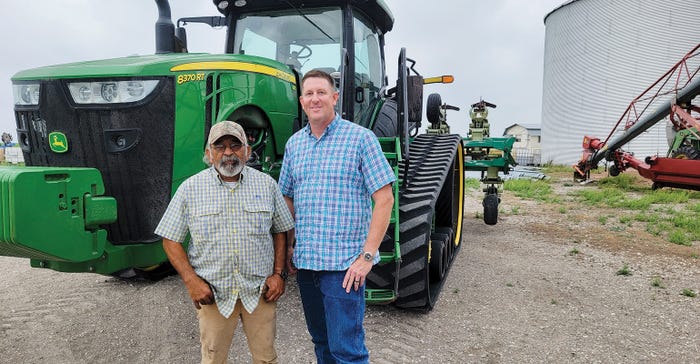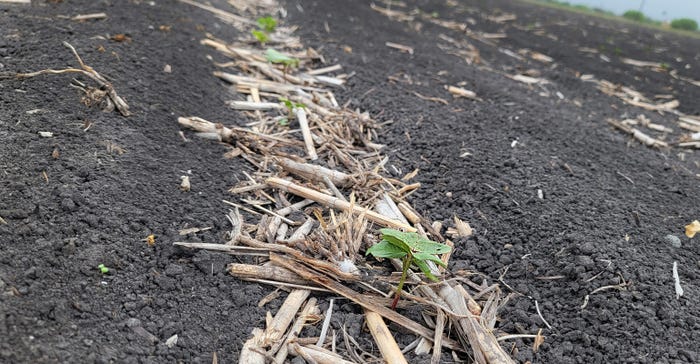
No matter the tillage practices, the persisting drought in South Texas is wreaking havoc on emerging crops.
"It seems that it didn’t matter whether you were conventional till or reduced till, across the board, there were lots of bad stands," says Robstown producer Jim Massey.
Massey, who grows corn, sorghum, and cotton, said there are good spots and bad spots, but "there's no definite or consistent pattern as to where it did come up or why it is a certain way."
 Jim Massey with longtime employee Juan Quiroz, who's worked for the Massey family since Jim was 5 years old. (Photos by Shelley E. Huguley)
Jim Massey with longtime employee Juan Quiroz, who's worked for the Massey family since Jim was 5 years old. (Photos by Shelley E. Huguley)
Massey vertical tills his fields. "We usually plow twice between harvest and planting. Of course, with the chemical prices where they are, a lot of people plowed more than they normally do because it was cheaper to plow than it was to spray. As a result, some fields were pulverized much more than they normally would be. In many cases, the powdered fields came up better than others because I think it was sealed off better from the dry wind coming through when the cotton was planted. It just seemed to be the luck of the draw on what worked and what didn't."
See, Drought grounds South Texas crop dusters
Massey began a transition from conventional tillage to vertical tillage in the early 2000s. While this shift has worked well with his cropping system, starting the season dry as it has been the last two seasons, he's had more clods than a conventionally plowed field. "It's made it tougher to get stands on the ends of the rows. Last year, we at least got a stand in the middle part of the field. This year, the milo and corn have been fine, but the cotton ran out of moisture, and it was difficult."
He said the conventional guys are also struggling with stand establishment. "So, I don't think it was strictly tillage practices that caused it."
Dry start
Similar to 2021, the 2022 season is starting off dry with the exception that it eventually rained last year. This year, producers like Massey aren't so sure. "It was really wet all last fall. We had a wet harvest and then in October it shut off and everything you did after that was losing moisture. It's just not rained much," he said.
 "I thought it (the corn) was going to die. In the hot afternoon, it just lays down. This plant is laying down. It can't handle the wind and the cracks," Jim Massey says.
"I thought it (the corn) was going to die. In the hot afternoon, it just lays down. This plant is laying down. It can't handle the wind and the cracks," Jim Massey says.
For about a week in January, the Nueces County region received about a half-inch drizzle. "It stayed cloudy in between, so we captured the whole it. But that's all the moisture we've had and that's what we planted on."
To further complicate matters, unseasonal springtime temperatures delayed planting. "We had a really cool spring. We were waiting to plant because it was so cool, yet every day we were losing moisture. We knew we only had one shot at it. You don't want to plant when it's too cold and then mess it up. So, we waited."
Massey says corn and milo planted "okay." Cotton was a different story. "Everybody got a stand but when it came to cotton, we were waiting on this last weekend cold front to pass. We had moisture and by the next Monday the moisture was gone, so we moved some dirt and planted it deep."
The low humidity and high winds dried out the fields quickly, Massey says. "We planted in moisture, but it dried out so fast, we had cotton up here and there, and all the plants in between sprouted but they didn't come up.
"Basically, the cotton ran out of gas."

A field of cotton planted near Robstown. Some cotton in the area emerged and some dried out.
Producers watched their fields for about three weeks thinking, "It's got to come up. It's sprouted. After the first week, it just stopped. It sat there for two more weeks and finally we had to make a decision. If you got a 10% or 15% stand, you're better off plowing and replanting than live with what you've got because that's never going to make a crop. Those that somehow got a decent enough stand, could leave it," he says.
Massey replanted 1,000 acres, two-thirds of his cotton. "I was able to leave a third of it. I'm not super happy with the stand, but it was at least leaveable. It's not good."
Going forward, Massey says if it doesn’t rain, what's up will likely die or produce very little. But producers are hopeful. "The last two years, we've had miracle rains in May. It saved us, and it kept raining. We're hoping that happens again. But it's not looking like that's the case. It's an unfortunate situation."
Read more about:
DroughtAbout the Author(s)
You May Also Like






